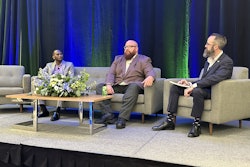Small businesses secured Small Business Administration backing under the agency’s flagship 7(a) program for 71,131 loans through the first nine months of the fiscal year – a 21 percent increase over the same period a year ago and a 49 percent increase over the same period two years ago. Loans executed so far this fiscal year amount to $11.1 billion – 19.5 percent more than in the same period last year. For information on applying for an SBA loan, visit this site.
The Internal Revenue Service has issued new rules, outlined in Revenue Procedure 2005-39, allowing corporate officers or authorized agents to sign employment tax forms by facsimile, including alternative signature methods such as computer software programs or mechanical devices. The rules are intended to reduce burden on business taxpayers by simplifying employment tax filing and lowering the number of returns rejected because of signature issues.
Small Business Administration last month launched a live Web chat series on entrepreneurship for small business owners. The chats will be held monthly on a variety of small business topics. For information, visit www.sba.gov.
The 2006 Toyota Highlander Hybrid and the 2006 Lexus RX 400h have been certified by the Internal Revenue Service as eligible for the clean-burning fuel deduction. Taxpayers purchasing one of these hybrid vehicles new during calendar year 2005 may claim a tax deduction of up to $2,000 on Form 1040.
You hate taxes. If you are like many other business executives, you complain bitterly when the time comes to make your hefty payment to Uncle Sam – and after the check is mailed, you promptly move on to your next operational or financial crisis. But do you really devote significant time and effort to ensuring that your tax bill is as small as absolutely possible?
You probably think it’s your CPA’s job to minimize your taxes. Truth is, the typical accounting firm has more than enough to do handling a client’s routine compliance issues; interim and yearend audits or reviews; multi-state corporate returns; subsidiary and consolidated returns; related entity returns for trusts or family LLCs; and owner/manager personal returns. Often there’s little time to sit back and actually plan for saving taxes.
The best time for comprehensive tax planning is in the summer or early fall months. Accounting and tax firms are busy in November and December helping clients implement pre-yearend tax saving strategies. And they are swamped January through April with yearend financial reports and the preparation of all those tax returns. Allowing a month for recovery and vacations, June through October becomes the only realistic time for clear-headed tax planning.
Time isn’t the only challenge, however. With ample work conducting audits and preparing tax returns, many small CPA firms don’t have experience conducting sophisticated tax planning. Consider retaining a specialty tax firm to work with your principal accounting firm on tax planning. With all the Sarbanes-Oxley reformations going on, using separate firms for audits and routine tasks is becoming common – even among some nonpublic companies.
In a typical comprehensive tax planning review, a team of partner- or manager-level specialists, perhaps accompanied by associates, conducts a two- or three-day onsite visit. The process involves a thorough review of several years’ returns and detailed interviews of the corporate officers and the family involved in the business. The review process generally is organized into five steps:
Review of corporate taxes. Each business is unique, not only in the scale of how it operates, but in the tax history and circumstances surrounding it. A critical consideration is the business’ choice of business entity. Should your company be a C corporation or S corporation? Should you move to the limited liability corporation (LLC) form or establish multiple LLCs to divide up the business to protect assets and lower taxes?
How effective is the overall tax compliance program? Are there any hidden exposures that are not being addressed, such as nexus in various states, transfer taxes between related entities, or opportunities to use one state with lower overall tax to the partial exclusion of a higher-tax state? What hidden treasures exist in oft-overlooked state tax breaks and credits?
For planned equipment purchases over the next year and beyond, which company structure would bring you the highest overall depreciation and tax advantages? Does it make sense to consider leasing or buying as the company grows? Reviewers will use exhaustive checklists with dozens of other such questions in seeking out opportunities for savings.
Review of personal taxes. Saving the most money on taxes requires planning corporate and personal taxes together. As company and personal wealth grows, asset protection, personal income tax avoidance and estate tax avoidance become major concerns.
Does a family LLC or family trust make sense? These popular tools help spread the income tax burden among family members to lower the overall total expense – perhaps by taking advantage of children’s lower tax rates, for example. How is the will structured now, and how could it be restructured to save estate taxes? Such strategies can begin a shift in wealth to the children without the older generation giving up control and decision-making authority.
The interplay between business and personal finances becomes more evident in the review of what personal executive benefit plans are available to the executive. For example, should the corporation adopt new plans that benefit the founding executives?
Review of owner’s long-range goals. Does the owner plan to hand over the business to his kids or sell it for the most he can get? Does he want to work until he can’t handle the rigors anymore? Or does he want to retire early and live in luxury?
Sadly, long-range goals usually are overlooked as tax professionals and business executives focus on year-to-year tax strategies. But to craft the best strategies over time, you must strike a balance between decisions that make tax sense and those that make sense for the owner and family. This requires thinking ahead five, 10 or perhaps more years.
Tax review memorandum. The product of all these reviews is a written report posing “what if” scenarios that help everyone understand the potential tax savings, the required restructuring steps and the estimated costs and benefits. Based on the complexity of the situation – and how much the client wants to spend – the tax review memorandum may be a brief summary letter or a comprehensive, detailed document complete with background cases.
Implementation. This time-consuming and costly work means nothing unless you act on it. Don’t release your adviser until he either helps implement your chosen strategies or provides a clear, detailed and specific road map. Implementation is a frustrating process, and inside controllers and chief financial officers often are too busy to lead it. Outside specialists often provide the most cost-effective way to assure that things actually happen – and that the tax savings have a chance to be achieved.
If you never have conducted a comprehensive tax planning review, take the time and spend the money. You’re likely to find some hidden treasure in your tax returns.
“Family Tax Planning,” Sam A. Hicks Jr., a detailed overview of a typical Comprehensive Tax Planning Review (website)
Do you want a 7(a)?
As you read on page 54, the number of loans granted under the Small Business Administration’s 7(a) loan program are up dramatically over the past couple of years. That raises some questions: What are 7(a) loans? How do they work?
SBA’s 7(a) loans are the most common loans the agency offers. The name is derived from the section of the Small Business Act that authorizes SBA to provide loans. But characterizing a 7(a) loan as a loan from SBA is a bit misleading. The loans actually are provided and administered by lenders that choose to participate in the program. Most U.S. banks are participants, and there are some non-bank lenders in the program. SBA itself doesn’t make loans.
Lenders participating in the 7(a) program structure their loans according to SBA requirements and apply for an SBA guaranty. SBA’s guaranty doesn’t cover the full loan amount, however. To discourage lenders from taking irresponsible risks, SBA insists that the agency and lender share the risk that a borrower can’t repay the loan in full.
A business seeking financing applies directly to a lender for a loan. If the business’ credit history or business plan is strong, the lender may grant the loan on its own. But if the loan has some weaknesses, the lender may choose to seek an SBA guaranty rather than simply reject financing.
If the guaranty is approved and the borrower defaults on payments, SBA will reimburse the lender for its loss, up to the guaranty percentage. It’s important to understand, however, that the guaranty is for the protection of the lender, not the borrower. If the borrower defaults on payments, it is still obligated to pay the full amount due.
The 7(a) loan program is an incentive to commercial lenders to provide loans to small businesses, but it in no way requires lenders to make loans they don’t want to make. If a lender isn’t willing to provide the loan even with the availability of an SBA guaranty, the agency can’t force the lender to do so. Therefore, even if your loan application qualifies for a guaranty, you may not get the loan.
Eligibility requirements
Like the underlying lender, SBA is concerned that the business obtaining a loan guaranty have the necessary cash flow to repay the loan. That’s the primary consideration, but good character, management capability, collateral and owner’s equity contribution also are important in SBA’s decision. Plus, SBA requires that all individuals holding 20 percent or more of the business provide personal guarantees.
SBA set up the eligibility requirements to be as broad as possible so that the agency could accommodate a diverse variety of businesses and business needs. To be considered for financing under the 7(a) loan program, a business must:
- Meet SBA size standards
- Be for-profit
- Lack internal business or personal resources to cover the financing needs
- Be able to demonstrate repayment.
For all types of trucking companies, the business must have less than $21.5 million in annual revenues to qualify. For other ventures, size standards are available at this site.
SBA also places restrictions on the type of businesses that quality. For example, one limitation that may be relevant occasionally in trucking is that franchises are eligible unless the franchisor retains so much power to control the operation that the arrangement is basically an employment contract. A franchisee must have the right to profit from efforts commensurate with ownership.
Another situation relevant to trucking is a loan for the purpose of changing ownership. These loans are eligible, provided SBA deems that the business benefits from the change. Those benefits would include promotion of business development or preserving the very existence of the business. Generally speaking, these loans are intended for partners buying out other partners. SBA won’t loan money for someone to buy part of a business in which it has no interest or to buy only a portion of an owner’s interest.
SBA loans are not available in situations where a principal is incarcerated, on parole, on probation or a defendant in a criminal proceeding. Nor can a principal qualify if he succeeds in getting probation or parole lifted expressly because the situation prevents him from getting an SBA loan.
The agency also won’t support certain businesses, such as real estate investments and other speculative activities; lending activities, illegal activities and gambling activities.
SBA also looks at the proposed use of the proceeds. Buying land, buildings or equipment are fine, as are obtaining working capital or refinancing to improve terms or conditions.
Ineligible uses include refinancing where the lender likely will sustain a loss, effecting a partial change of business ownership or a change that will not benefit the business, and repaying delinquent state or federal withholding taxes.
Loan terms
SBA’s 7(a) loans are limited to no more than $2 million, with SBA’s maximum exposure $1.5 million. Loan maturities vary according to ability to repay, purpose of the loan and the useful life of assets to be financed. There are maximum loan maturities, however: 25 years for real estate and equipment and, generally, 7 years for working capital. SBA may allow 10 years for repaying working capital loans if necessary to ensure repayment.
Fixed or variable interest rates are negotiated between the borrower and the lender but are subject to SBA maximums that are pegged to the prime rate. To offset the costs of the SBA’s loan programs to the taxpayer, the agency charges lenders a guaranty fee and a servicing fee for each loan approved and disbursed. The lender may charge the upfront guaranty fee to the borrower after the lender has paid the fee to SBA and has made the first disbursement of the loan.
For more information on SBA’s 7(a) loans, visit this site.
—Avery Vise









